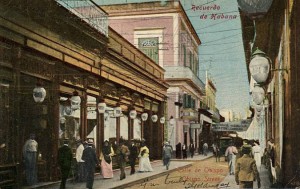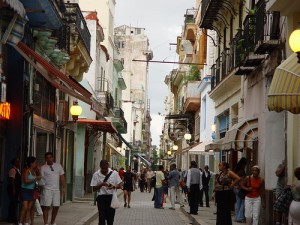 Obispo Street, one of the oldest in Havana, begins in the sea and culminates in Monserrate. It is crossed by dozens of street ranging from the Avenida del Puerto and the neighborhoods adjacent to the Old Quarter, which increases its noisy and colorful vitality without diminishing the glamor lent it by its shopping centers, museums, libraries, hotels, banks, government agencies and other entities the Office of the City Historian is trying to restore.
Obispo Street, one of the oldest in Havana, begins in the sea and culminates in Monserrate. It is crossed by dozens of street ranging from the Avenida del Puerto and the neighborhoods adjacent to the Old Quarter, which increases its noisy and colorful vitality without diminishing the glamor lent it by its shopping centers, museums, libraries, hotels, banks, government agencies and other entities the Office of the City Historian is trying to restore.
Only the Municipal Acts, some newspapers and magazines and two or three history books about the Cuban capital relate the names and locations of the various centers that made Obispo into “the street of the streets,” followed later by Galiano, San Rafael and Prado; it is even compared for its elegance with Rue de Paix (Paris), San Fernando (Barcelona), La Sierpe (Sevilla), the Carrera de San Jeronimo (Madrid) as well as the aged streets of New York.
Almost no one remembers that until 1898 it was crossed each morning by a company of Spanish volunteers who marched under the strains of a band, from the Prado to the sea, where they were spread out to guard the Palacio de los Capitanes Generale, the Palacio del Segundo Cabo, the Castillo de la Fuerza, the Spanish Bank and other civilian and military defenses of the colonial period.
Despite the weather, the expropriations of the 1960s and the circumstances that marked the urban involution, Obispo retains its original layout of a noisy, narrow street with shops on both sides of the pedestrian sidewalk passersby who disappear into a corner, go to a boutique or head off to a scheduled meeting.
Centuries later, Obispo oscillates between a colonial provincial atmosphere and a sense of modernity brought by the merchants and public figures during the Republic. The paving stones were replaced by asphalt, reborn entities and stores in ruins, like the House of Happy Father Varela, recycled into a school library; the Hotel Florida, which had among its guests the Spanish philologist Ramón Menéndez Pidal in 1937; the Almendrares optician and Café Europa, literary scene of the narratives of Carlos Loveira and Luís Bonafoux.
The University of Havana started on Obispo Street, where it was located between 1728 and 1902 in the Dominican Convent, also the venue of Secondary School of Havana, whose students snack in front, in the The Angel Bakery or in the French pastry shop, Brasy. On demolishing the convent, in the late 50’s, the building of the Ministry of Education was built, which shares space with real estate offices.
Where the current Ministry of Finances and Prices was once the Wilson House perfumery and National Bank built by the tycoon Pote; later it was occupied by the General Treasury of the Republic and the Ministry of Finance. Poe should also be credited with The Modern Poetry bookstore, built in 1900 at Obispo and Bernaza, opposite the Ricoy bookstore, now Cervantes, where eminent personalities from the country’s cultural and political spheres met.
These were followed by the Anselmo Lopez piano store, the ironmonger’s, and the Bosque de Boloña store, later relocated to the corner of Compostela. Almost at the beginning and near the Plazoleta de Albear were found the El Casino hat store, and the La Cebada cafe, very popular with the drivers until its sale and conversion to the Floridita Bar, home of writer Ernest Hemingway, who stayed at the hotel Ambos Mundos before acquiring the Vigia in San Francisco de Paula.
Historians and planners say Obispo Street, so hot in summer and cold in winter, owes its charm to its geographical position and the network of shops, banks and bureaucracies, refined by the latest offers of clothing and the cultural flow triggered by the installation of printers, newspapers, bookstores, publishing houses, law firms, pharmacies and other agencies the diverse social sectors attract, turning it into an urban paradigm.
 Among financial centers We think of the Bances y Conde Bank, the Spanish Bank, which went bankrupt in 1921, the Trade Development Bank, the Trust Company of Cuba and the Núñez Bank, considered in 1957 to be among the world’s most important institutions.
Among financial centers We think of the Bances y Conde Bank, the Spanish Bank, which went bankrupt in 1921, the Trade Development Bank, the Trust Company of Cuba and the Núñez Bank, considered in 1957 to be among the world’s most important institutions.
Obispo integrates the tangible and spiritual heritage of Havana. Many establishments have disappeared, but are the Johnson and Taquechel drugstores are kept, the Anteojo Opticians, and the old houses are repaired for Museums (La Plata), libraries and offices (Department of Housing and Land Registry) and restaurants and cafes for tourists.
September 26, 2010
